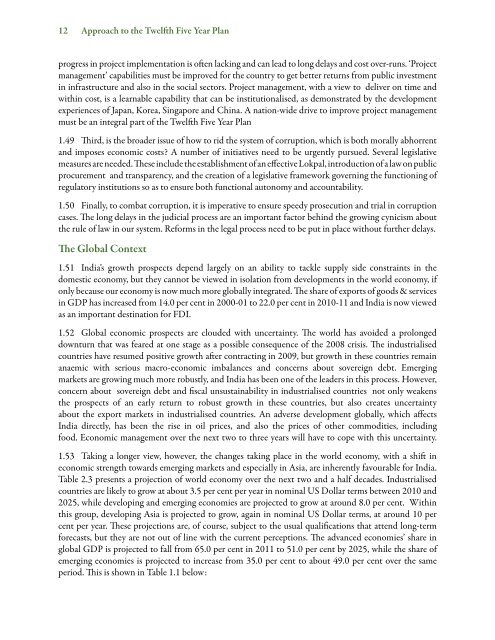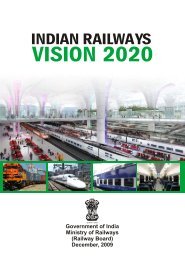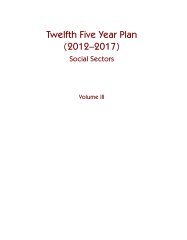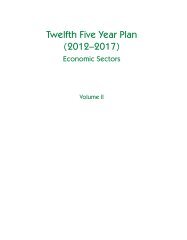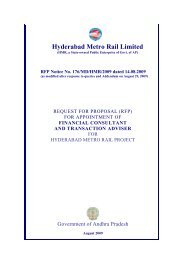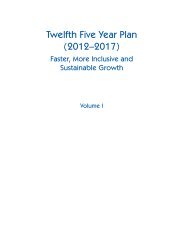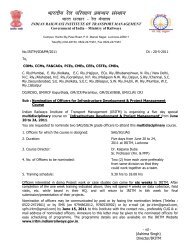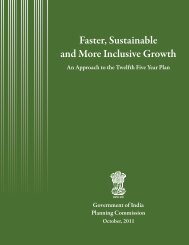Approach 12 FYP - Indian Railways Institute of Transport Management
Approach 12 FYP - Indian Railways Institute of Transport Management
Approach 12 FYP - Indian Railways Institute of Transport Management
Create successful ePaper yourself
Turn your PDF publications into a flip-book with our unique Google optimized e-Paper software.
<strong>12</strong> <strong>Approach</strong> to the Twelfth Five Year Plan<br />
progress in project implementation is <strong>of</strong>ten lacking and can lead to long delays and cost over-runs. ‘Project<br />
management’ capabilities must be improved for the country to get better returns from public investment<br />
in infrastructure and also in the social sectors. Project management, with a view to deliver on time and<br />
within cost, is a learnable capability that can be institutionalised, as demonstrated by the development<br />
experiences <strong>of</strong> Japan, Korea, Singapore and China. A nation-wide drive to improve project management<br />
must be an integral part <strong>of</strong> the Twelfth Five Year Plan<br />
1.49 Third, is the broader issue <strong>of</strong> how to rid the system <strong>of</strong> corruption, which is both morally abhorrent<br />
and imposes economic costs? A number <strong>of</strong> initiatives need to be urgently pursued. Several legislative<br />
measures are needed. These include the establishment <strong>of</strong> an effective Lokpal, introduction <strong>of</strong> a law on public<br />
procurement and transparency, and the creation <strong>of</strong> a legislative framework governing the functioning <strong>of</strong><br />
regulatory institutions so as to ensure both functional autonomy and accountability.<br />
1.50 Finally, to combat corruption, it is imperative to ensure speedy prosecution and trial in corruption<br />
cases. The long delays in the judicial process are an important factor behind the growing cynicism about<br />
the rule <strong>of</strong> law in our system. Reforms in the legal process need to be put in place without further delays.<br />
The Global Context<br />
1.51 India’s growth prospects depend largely on an ability to tackle supply side constraints in the<br />
domestic economy, but they cannot be viewed in isolation from developments in the world economy, if<br />
only because our economy is now much more globally integrated. The share <strong>of</strong> exports <strong>of</strong> goods & services<br />
in GDP has increased from 14.0 per cent in 2000-01 to 22.0 per cent in 2010-11 and India is now viewed<br />
as an important destination for FDI.<br />
1.52 Global economic prospects are clouded with uncertainty. The world has avoided a prolonged<br />
downturn that was feared at one stage as a possible consequence <strong>of</strong> the 2008 crisis. The industrialised<br />
countries have resumed positive growth after contracting in 2009, but growth in these countries remain<br />
anaemic with serious macro-economic imbalances and concerns about sovereign debt. Emerging<br />
markets are growing much more robustly, and India has been one <strong>of</strong> the leaders in this process. However,<br />
concern about sovereign debt and fiscal unsustainability in industrialised countries not only weakens<br />
the prospects <strong>of</strong> an early return to robust growth in these countries, but also creates uncertainty<br />
about the export markets in industrialised countries. An adverse development globally, which affects<br />
India directly, has been the rise in oil prices, and also the prices <strong>of</strong> other commodities, including<br />
food. Economic management over the next two to three years will have to cope with this uncertainty.<br />
1.53 Taking a longer view, however, the changes taking place in the world economy, with a shift in<br />
economic strength towards emerging markets and especially in Asia, are inherently favourable for India.<br />
Table 2.3 presents a projection <strong>of</strong> world economy over the next two and a half decades. Industrialised<br />
countries are likely to grow at about 3.5 per cent per year in nominal US Dollar terms between 2010 and<br />
2025, while developing and emerging economies are projected to grow at around 8.0 per cent. Within<br />
this group, developing Asia is projected to grow, again in nominal US Dollar terms, at around 10 per<br />
cent per year. These projections are, <strong>of</strong> course, subject to the usual qualifications that attend long-term<br />
forecasts, but they are not out <strong>of</strong> line with the current perceptions. The advanced economies’ share in<br />
global GDP is projected to fall from 65.0 per cent in 2011 to 51.0 per cent by 2025, while the share <strong>of</strong><br />
emerging economies is projected to increase from 35.0 per cent to about 49.0 per cent over the same<br />
period. This is shown in Table 1.1 below:


